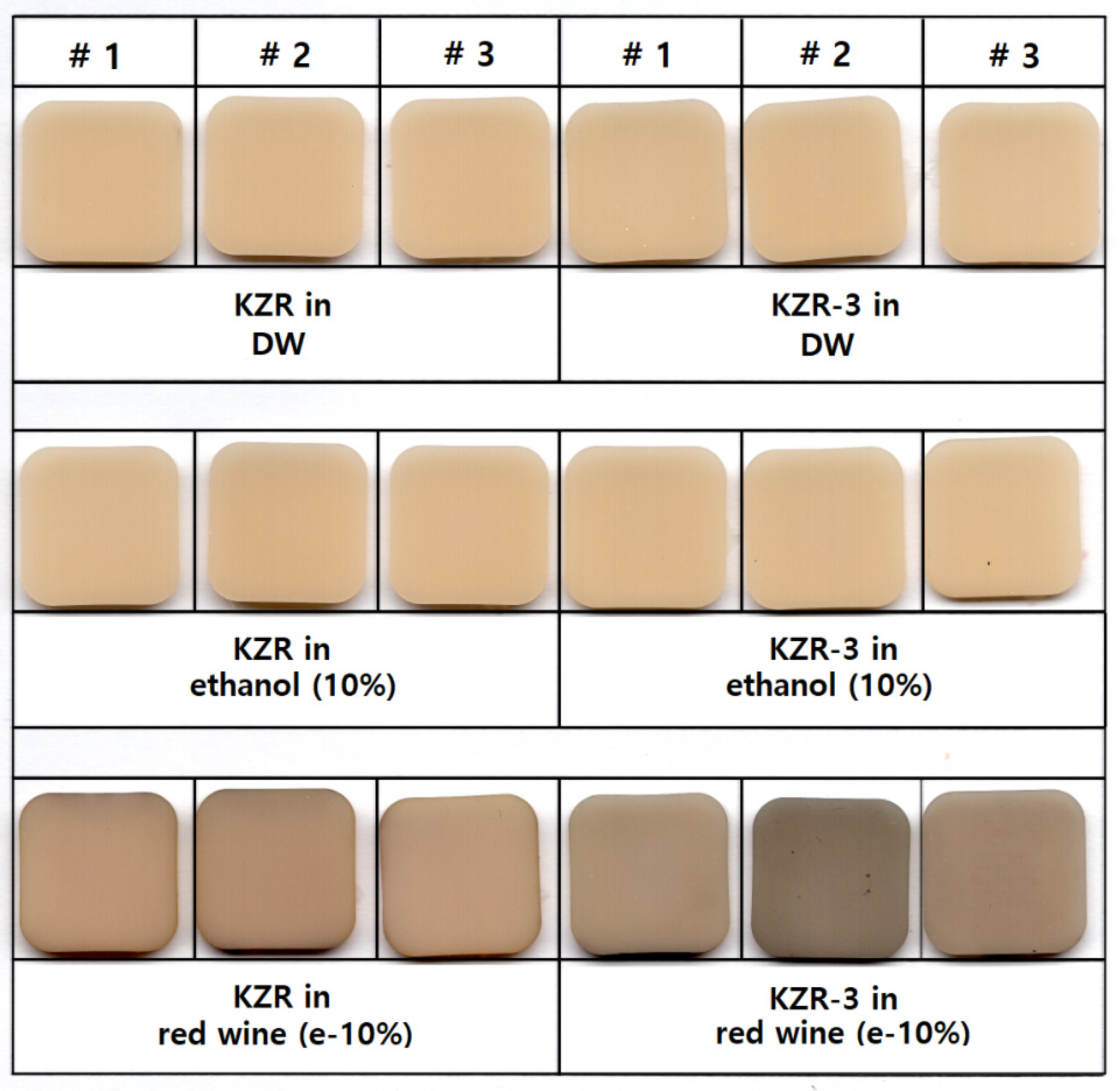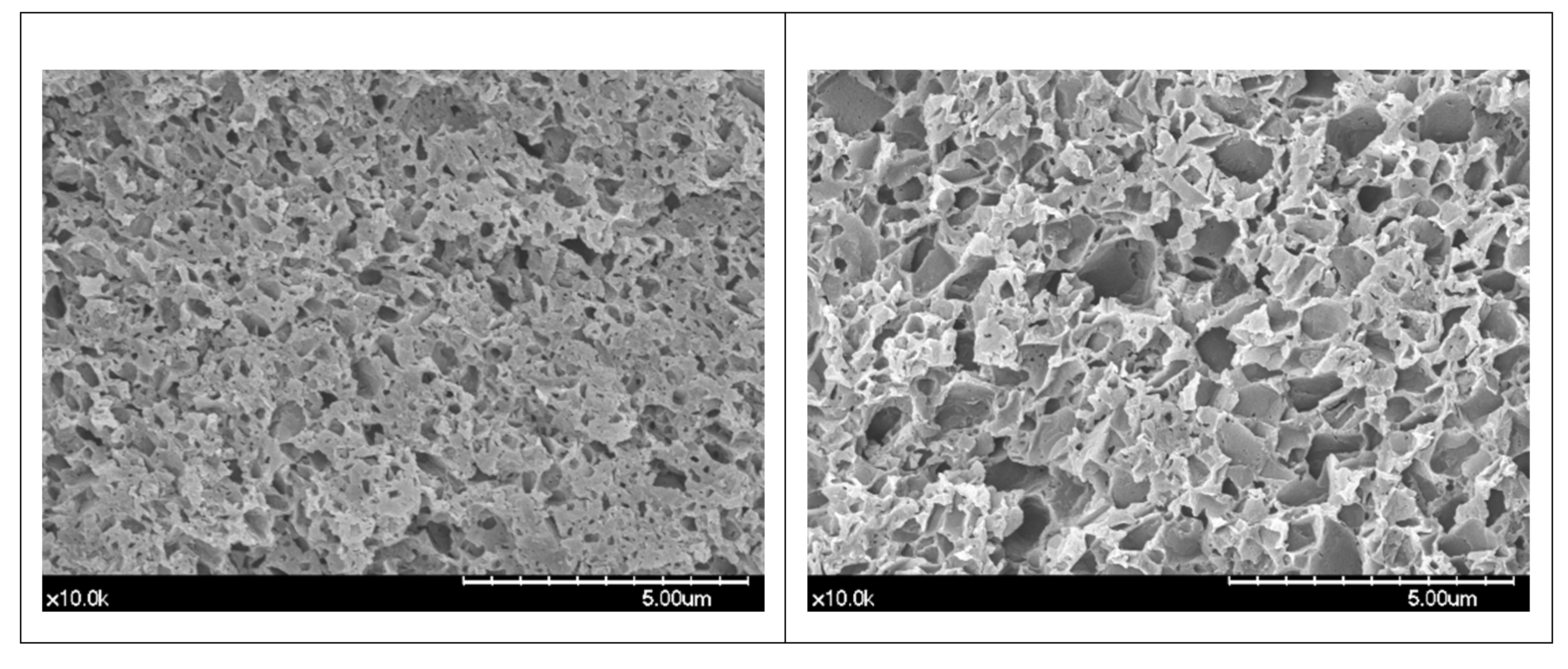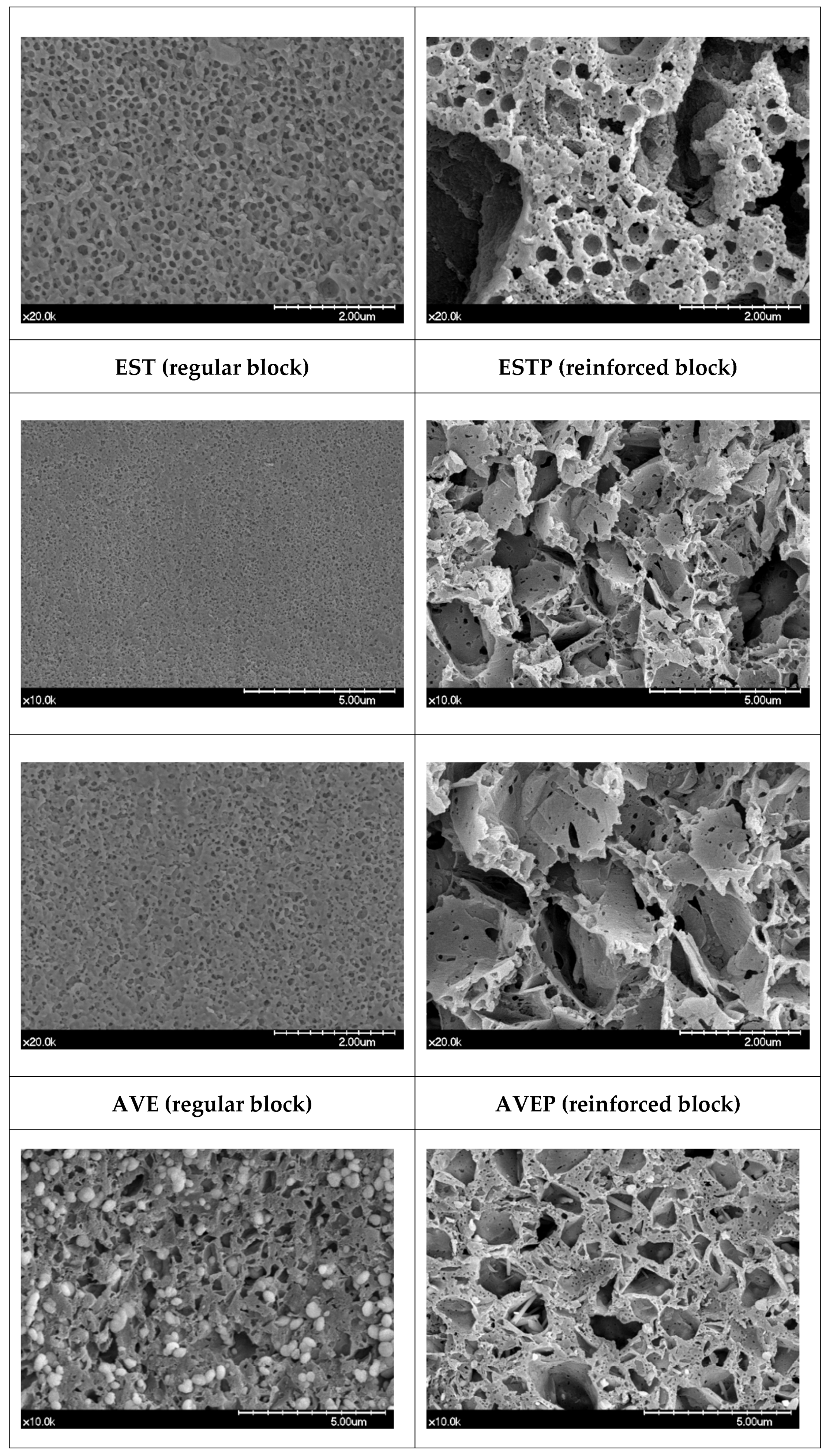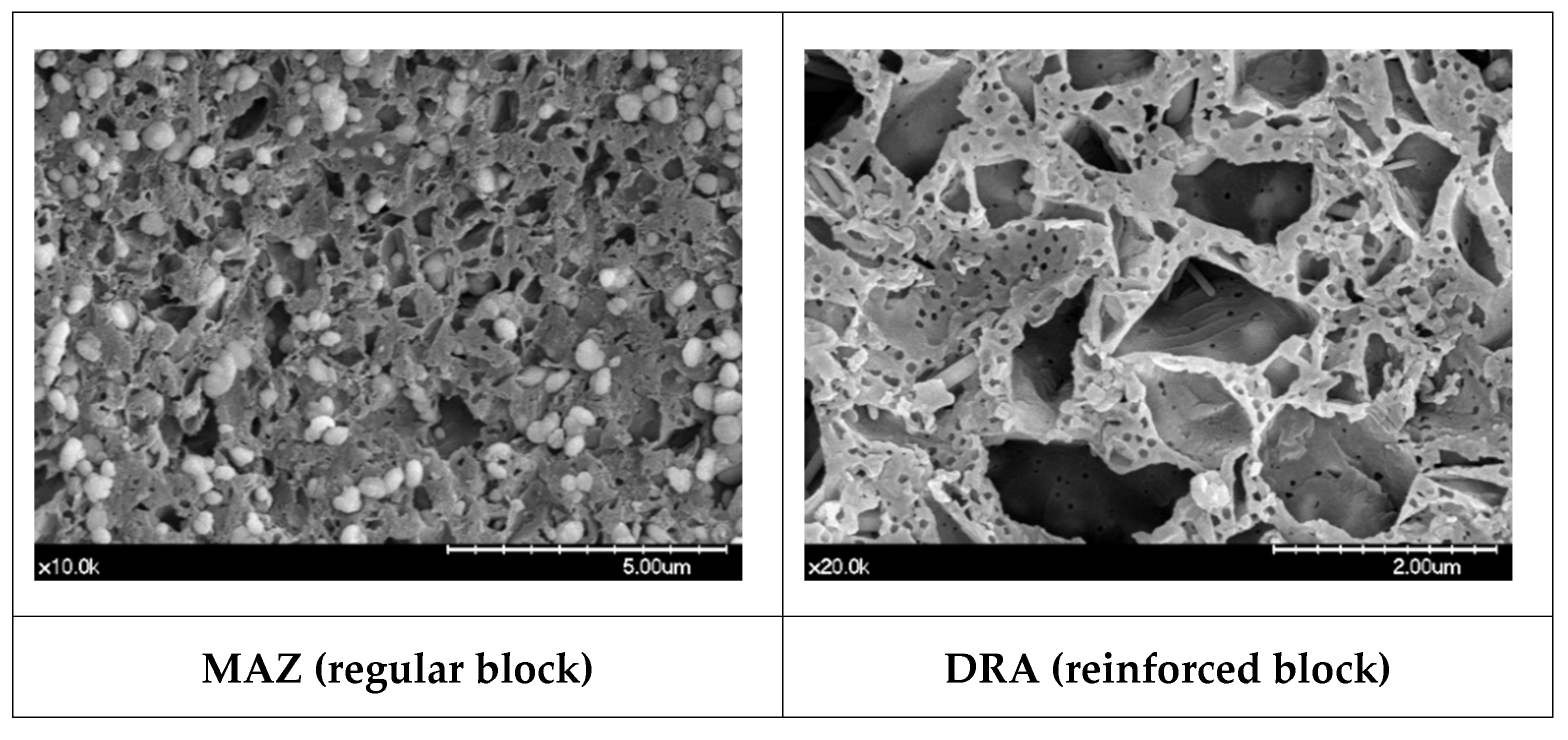Color Stability of Dental Reinforced CAD/CAM Hybrid Composite Blocks Compared to Regular Blocks
Abstract
:1. Introduction
2. Materials and Methods
2.1. Hybrid Composite Block Specimen and Staining Solution
2.2. Color and Translucency Measurement
2.3. Examination of Microstructure of Hybrid Block
3. Results
4. Discussion
5. Conclusions
Author Contributions
Funding
Conflicts of Interest
References
- Mainjot, A.K.; Dupont, N.M.; Oudkerk, J.C.; Dewael, T.Y.; Sadoun, M.J. From Artisan to CAD-CAM blocks: State of the art of indirect composites. J. Dent. Res. 2016, 95, 487–495. [Google Scholar] [CrossRef] [PubMed]
- Nguyen, J.F.; Migonney, V.; Ruse, N.D.; Sadoun, M. Resin composite blocks via high-pressure high-temperature polymerization. Dent. Mater. 2012, 28, 529–534. [Google Scholar] [CrossRef] [PubMed]
- Alamoush, R.A.; Silikas, N.; Salim, N.A.; Al-Nasrawi, S.; Satterthwaite, J.D. Effect of the composition of CAD/CAM composite blocks on mechanical properties. BioMed Res. Int. 2018, 2018, 4893143. [Google Scholar] [CrossRef] [PubMed]
- Seyidaliyeva, A.; Rues, S.; Evagorou, Z.; Hassel, A.J.; Rammelsberg, P.; Zenthöfer, A. Color stability of polymer-infiltrated-ceramics compared with lithium disilicate ceramics and composite. J. Esthet. Restor. Dent. 2020, 32, 43–50. [Google Scholar] [CrossRef] [Green Version]
- Mourouzis, P.; Andreasidou, E.; Samanidou, V.; Tolidis, K. Short-term and long-term release of monomers from newly developed resin-modified ceramics and composite resin CAD-CAM blocks. J. Prosthet. Dent. 2020, 123, 339–348. [Google Scholar] [CrossRef]
- Karaer, O.; Yamaguchi, S.; Nakase, Y.; Lee, C.; Imazato, S. In silico non-linear dynamic analysis reflecting in vitro physical properties of CAD/CAM resin composite blocks. J. Mech. Behav. Biomed. Mater. 2020, 104, 103697. [Google Scholar] [CrossRef]
- Stawarczyk, B.; Sener, B.; Trottmann, A.; Roos, M.; Ozcan, M.; Hämmerle, C.H. Discoloration of manually fabricated resins and industrially fabricated CAD/CAM blocks versus glass-ceramic: Effect of storage media, duration, and subsequent polishing. Dent. Mater. J. 2012, 31, 377–383. [Google Scholar] [CrossRef] [Green Version]
- Acar, O.; Yilmaz, B.; Altintas, S.H.; Chandrasekaran, I.; Johnston, W.M. Color stainability of CAD/CAM and nanocomposite resin materials. J. Prosthet. Dent. 2016, 115, 71–75. [Google Scholar] [CrossRef]
- Chakravarthy, Y.; Clarence, S. The effect of red wine on colour stability of three different types of esthetic restorative materials: An in vitro study. J. Conserv. Dent. 2018, 21, 319–323. [Google Scholar]
- Patel, S.B.; Gordan, V.V.; Barrett, A.A.; Shen, C. The effect of surface finishing and storage solutions on the color stability of resin-based composites. J. Am. Dent. Assoc. 2004, 135, 587–594. [Google Scholar] [CrossRef]
- Ertaş, E.; Güler, A.U.; Yücel, A.C.; Köprülü, H.; Güler, E. Color stability of resin composites after immersion in different drinks. Dent. Mater. J. 2006, 25, 371–376. [Google Scholar] [CrossRef] [PubMed] [Green Version]
- Schroeder, T.; da Silva, P.B.; Basso, G.R.; Franco, M.C.; Maske, T.T.; Cenci, M.S. Factors affecting the color stability and staining of esthetic restorations. Odontology 2019, 107, 507–512. [Google Scholar] [CrossRef]
- Bagheri, R.; Burrow, M.F.; Tyas, M. Influence of food-simulating solutions and surface finish on susceptibility to staining of aesthetic restorative materials. J. Dent. 2005, 33, 389–398. [Google Scholar] [CrossRef] [PubMed]
- Ardu, S.; Braut, V.; Gutemberg, D.; Krejci, I.; Dietschi, D.; Feilzer, A.J. A long-term laboratory test on staining susceptibility of esthetic composite resin materials. Quintessence Int. 2010, 41, 695–702. [Google Scholar]
- Awad, D.; Stawarczyk, B.; Liebermann, A.; Ilie, N. Translucency of esthetic dental restorative CAD/CAM materials and composite resins with respect to thickness and surface roughness. J. Prosthet. Dent. 2015, 113, 534–540. [Google Scholar] [CrossRef]
- Buyukkaplan, S.U.; Özarslan, M.M.; Barutcigil, Ç.; Arslan, M.; Barutcigil, K.; Yoldan, E.E. Effects of staining liquids and finishing methods on translucency of a hybrid ceramic material having two different translucency levels. J. Adv. Prosthodont. 2017, 9, 387–393. [Google Scholar] [CrossRef] [PubMed]
- Quek, S.H.Q.; Yap, A.U.J.; Rosa, V.; Tan, K.B.C.; Teoh, K.H. Effect of staining beverages on color and translucency of CAD/CAM composites. J. Esthet. Restor. Dent. 2018, 30, e9–e17. [Google Scholar] [CrossRef]
- Hwang, S.; Lee, J.T.; Kim, Y.T.; Chung, S.H.; Yeo, I.S.L. Color changes of oral composite resins and decrease in surface micro hardness caused by commercial alcoholic drinks. Transylv. Rev. 2017, 25, 3717–3723. [Google Scholar]
- Khosravi, M.; Behnaz, E.; Forough, N.; Soraya, K. Color stability of nanofilled and microhybrid resin-based composites following exposure to chlorhexidine mouthrinses: An in vitro study. J. Dent. (Tehran, Iran) 2016, 13, 116–125. [Google Scholar]
- Bansal, K.; Acharya, S.R.; Saraswathi, V. Effect of alcoholic and non-alcoholic beverages on color stability and surface roughness of resin composites: An in vitro study. J. Conserv. Dent. 2012, 15, 283–288. [Google Scholar] [CrossRef] [Green Version]
- Abu-Bakr, N.; Han, L.; Okamoto, A.; Iwaku, M. Color stability of compomer after immersion in various media. J. Esthet. Dent. 2000, 12, 258–263. [Google Scholar] [CrossRef] [PubMed]
- Khokhar, Z.A.; Razzoog, M.E.; Yaman, P. Color stability of restorative resins. Quintessence Int. 1991, 22, 733–737. [Google Scholar]
- Ruyter, I.E.; Nilner, K.; Moller, B. Color stability of dental composite resin materials for crown and bridge veneers. Dent. Mater. 1987, 3, 246–251. [Google Scholar] [CrossRef]
- Um, C.M.; Ruyter, I.E. Staining of resin-based veneering materials with coffee and tea. Quintessence Int. 1991, 22, 377–386. [Google Scholar] [PubMed]
- Wang, H.; Xiong, F.; Zhenhua, L. Influence of varied surface texture of dentin porcelain on optical properties of porcelain specimens. J. Prosthet. Dent. 2011, 105, 242–248. [Google Scholar] [CrossRef]
- Lise, D.P.; Van Ende, A.; De Munck, J.; Yoshihara, K.; Nagaoka, N.; Cardoso Vieira, L.C.; van Meerbeek, B. Light irradiance through novel CAD-CAM block materials and degree of conversion of composite cements. Dent. Mater. 2018, 34, 296–305. [Google Scholar] [CrossRef]
- Ahn, J.S.; Lee, Y.K. Difference in the translucency of all-ceramics by the illuminant. Dent. Mater. 2008, 24, 1539–1544. [Google Scholar] [CrossRef]
- Arocha, M.A.; Basilio, J.; Llopis, J.; di Bella, E.; Roig, M.; Ardu, S.; Mayoral, J.R. Colour stainability of indirect CAD-CAM processed composites vs. conventionally laboratory processed composites after immersion in staining solutions. J. Dent. 2014, 42, 831–838. [Google Scholar] [CrossRef]
- Topcu, F.T.; Sahinkesen, G.; Yamanel, K.; Erdemir, U.; Oktay, E.A.; Ersahan, S. Influence of different drinks on the colour stability of dental resin composites. Eur. J. Dent. 2009, 3, 50–56. [Google Scholar] [CrossRef] [Green Version]
- Ferracane, J.L.; Marker, V.A. Solvent degradation and reduced fracture toughness in aged composites. J. Dent. Res. 1992, 71, 13–19. [Google Scholar] [CrossRef]
- Deepa, C.S.; Krishnan, V.K. Effect of resin matrix ratio, storage medium, and time upon the physical properties of a radiopaque dental composite. J. Biomater. Appl. 2000, 14, 296–315. [Google Scholar] [CrossRef]
- Hwang, S.; Chung, S.H.; Lee, J.T.; Kim, Y.T.; Kim, Y.J.; Oh, S.; Yeo, I.L. Influence of acid, ethanol, and anthocyanin pigment on the optical and mechanical properties of a nanohybrid dental composite resin. Materials 2018, 11, 1234. [Google Scholar] [CrossRef] [PubMed] [Green Version]
- Setz, J.; Geis-Gerstorfer, J.; Lin, W. The effect of inorganic fillers on the properties of light-curing composites. Ditsch. Zahnarztl. Z. 1991, 46, 657–660. [Google Scholar]
- Dietschi, D.; Campanile, G.; Holz, J.; Meyer, J.M. Comparison of the color stability of ten new-generation composites: An in vitro study. Dent. Mater. 1994, 10, 353–362. [Google Scholar] [CrossRef]
- Vichi, A.; Ferrari, M.; Davidson, C.L. Color and opacity variations in three different resin-based composite products after water aging. Dent. Mater. 2004, 20, 530–534. [Google Scholar] [CrossRef] [Green Version]
- Oysaed, H.; Ruyter, I.E. Water sorption and filler characteristic of composites for use in posterior teeth. J. Dent. Res. 1986, 65, 1315–1318. [Google Scholar] [CrossRef] [PubMed]
- Shintani, H.; Satou, J.; Satou, N.; Hayashihara, H.; Inoue, T. The effects of various finishing methods on staining and accumulation of Streptococcus mutans HS-6 on composite resins. Dent. Mater. 1985, 1, 225–227. [Google Scholar] [CrossRef]
- Gajewski, V.E.; Pfeifer, C.S.; Froes-Salgado, N.R.; Boaro, L.C.; Braga, R.R. Monomers used in resin composites: Degree of conversion, mechanical properties and water sorption/solubility. Braz. Dent. J. 2012, 23, 508–514. [Google Scholar] [CrossRef]
- Pearson, G.J.; Longman, C.M. Water sorption and solubility of resin- based materials following inadequate polymerization by a visible- light curing system. J. Oral Rehab. 1989, 16, 57–61. [Google Scholar] [CrossRef]
- Alharbi, A.; Ardu, S.; Bortolotto, T.; Krejci, I. Stain susceptibility of composite and ceramic CAD/CAM blocks versus direct resin composites with different resinous matrices. Odontology 2017, 105, 162–169. [Google Scholar] [CrossRef] [Green Version]
- Nguyen, J.F.; Migonney, V.; Ruse, N.D.; Sadoun, M. Properties of experimental urethane dimethacrylate-based dental resin composite blocks obtained via thermo-polymerization under high pressure. Dent. Mater. 2013, 29, 535–541. [Google Scholar] [CrossRef] [PubMed]
- Ardu, S.; Krejci, I. Biomimetic direct composite stratification technique for the restoration of anterior teeth. Quintessence Int. 2006, 37, 167–174. [Google Scholar] [PubMed]
- Mair, L.H. Staining of in vitro subsurface degradation in dental composite with silver nitrate. J. Dent. Res. 1991, 70, 215–220. [Google Scholar] [CrossRef] [PubMed]
- Rueggeberg, F.A.; Margeson, D.H. The effect of oxygen inhibition on unfilled/filled composite system. J. Dent. Res. 1990, 69, 1652–1658. [Google Scholar] [CrossRef]
- Lauvahutanon, S.; Shiozawa, M.; Takahashi, H.; Iwasaki, N.; Oki, M.; Finger, W.J.; Arksornnukit, M. Discoloration of various CAD/CAM blocks after immersion in coffee. Restor. Dent. Endod. 2017, 42, 9–18. [Google Scholar] [CrossRef]
- Aydın, N.; Karaoğlanoğlu, S.; Oktay, E.A.; Kılıçarslan, M.A. Investigating the color changes on resin-based CAD/CAM Blocks. J. Esthet. Restor. Dent. 2020, 32, 251–256. [Google Scholar] [CrossRef]
- Azzopardi, N.; Moharamzadeh, K.; Wood, D.J.; Martin, N.; van Noort, R. Effect of resin matrix composition on the translucency of experimental dental composite resins. Dent. Mater. 2009, 25, 1564–1568. [Google Scholar] [CrossRef]
- Özarslan, M.M.; Büyükkaplan, U.Ş.; Barutcigil, Ç.; Özarslan, M.; Barutcigil, K.; Türker, N. Assessing staining resistance of a CAD/CAM inter- penetrating network composite material. Head Face Med. 2018, 14, 27. [Google Scholar] [CrossRef]
- Lee, Y.K. Criteria for clinical translucency evaluation of direct esthetic restorative materials. Restor. Dent. Endod. 2016, 41, 159–166. [Google Scholar] [CrossRef] [Green Version]





| Code | Name | Main Components | Filler Fraction | Lot # | Manufacturer |
|---|---|---|---|---|---|
| CER2 | Cerasmart 200 | Bis-MEPP *, UDMA, DMA, Ba-glass, silica | 71 wt.% | 1603081 | GC, Japan |
| CER3 | Cerasmart 300 | UDMA, Bis-MEPP, Ba-glass, silica | 78 wt.% | 1808292 | |
| KZR | KZR-CAD HR | UDMA, TEGDMA, SiO2 + Al2O3 + ZrO2, SiO2 | 79 wt.% | 01011622 | Yamakin, Japan |
| KZR3 | KZR-CAD HR3 | UDMA, DEGDMA, SiO2 + Al2O3 + ZrO2, SiO2 | 75 wt.% | 01111807 | |
| EST | Estelite Block | UDMA, TEGDMA, silica, silica-zirconia | 75 wt.% | 0070Z5 | Tokuyama Dental, Japan |
| ESTP | Estelite P Block | Bis-MPEPP, UDMA, NPGDMA, silica, silica-zirconia filler | 81 wt.% | 011049 | |
| AVE | Katana Avencia Block | UDMA, TEGDMA, silica, alumina filler | 62 wt.% | 000123 | Kuraray, Japan |
| AVEP | Katana Avencia P Block | UDMA, Ba-glass, silica | 82 wt.% | 000043 | |
| MAZ | Mazic Duro | Bis-GMA, TEGDMA, silica, Ba-glass, ZrO2 | 77 wt.% | DH6504A2 | Vericom, Korea |
| DRA | Duro Ace | UDMA, Bis-EMA, silica, Ba-glass | 85 wt.% | 1002-2 |
| Solution | Code | 1 Week | 2 Weeks | 4 Weeks | 6 Weeks | 8 Weeks | 12 Weeks |
|---|---|---|---|---|---|---|---|
| Deionized water | CER2 | 0.87 ± 0.67 | 1.04 ± 0.70 | 0.82 ± 0.24 | 1.13 ± 0.40 | 0.97 ± 0.68 | 1.66 ± 0.16 |
| CER3 | 0.58 ± 0.75 | 0.91 ± 0.65 | 0.74 ± 0.82 | 0.76 ± 0.49 | 0.52 ± 0.37 | 1.55 ± 0.45 | |
| KZR | 0.71 ± 0.15 | 0.79 ± 0.20 | 0.80 ± 0.13 | 0.94 ± 0.06 | 0.80 ± 0.21 | 0.98 ± 0.24 | |
| KZR3 | 1.14 ± 0.36 | 1.13 ± 0.38 | 1.36 ± 0.34 | 1.57 ± 0.61 | 1.61 ± 0.36 | 1.57 ± 0.43 | |
| EST | 0.27 ± 0.15 | 0.48 ± 0.38 | 0.69 ± 0.27 | 1.03 ± 0.13 | 1.20 ± 0.28 | 2.04 ± 0.11 | |
| ESTP | 0.59 ± 0.29 | 0.53 ± 0.18 | 0.70 ± 0.30 | 0.50 ± 0.09 | 0.68 ± 0.28 | 0.85 ± 0.06 | |
| AVE | 0.53 ± 0.25 | 0.37 ± 0.08 | 0.34 ± 0.03 | 0.26 ± 0.03 | 0.29 ± 0.03 | 0.58 ± 0.01 | |
| AVEP | 2.23 ± 0.58 | 3.06 ± 0.76 | 3.67 ± 0.67 | 3.63 ± 0.56 | 3.76 ± 0.75 | 3.60 ± 0.75 | |
| MAZ | 1.07 ± 0.25 | 1.14 ± 0.25 | 1.14 ± 0.18 | 1.21 ± 0.20 | 1.18 ± 0.29 | 1.25 ± 0.27 | |
| DRA | 1.70 ± 0.30 | 1.82 ± 0.60 | 1.82 ± 0.37 | 1.63 ± 0.16 | 1.86 ± 0.29 | 2.15 ± 0.29 | |
| 10% ethanol | CER2 | 0.62 ± 0.50 | 0.98 ± 0.01 | 0.45 ± 0.24 | 0.68 ± 0.34 | 0.77 ± 0.36 | 0.93 ± 0.39 |
| CER3 | 1.28 ± 0.13 | 1.24 ± 0.36 | 0.88 ± 0.22 | 1.33 ± 0.50 | 1.34 ± 0.55 | 1.52 ± 0.49 | |
| KZR | 1.03 ± 0.42 | 1.27 ± 0.35 | 1.04 ± 0.22 | 1.17 ± 0.39 | 0.97 ± 0.22 | 1.13 ± 0.38 | |
| KZR3 | 1.05 ± 0.46 | 1.14 ± 0.15 | 1.40 ± 0.21 | 1.06 ± 0.49 | 1.63 ± 0.24 | 1.51 ± 0.75 | |
| EST | 0.38 ± 0.10 | 0.42 ± 0.04 | 0.56 ± 0.16 | 0.67 ± 0.17 | 0.73 ± 0.04 | 1.45 ± 0.23 | |
| ESTP | 0.31 ± 0.09 | 0.50 ± 0.21 | 0.45 ± 0.15 | 0.60 ± 0.13 | 0.52 ± 0.07 | 0.93 ± 0.19 | |
| AVE | 0.52 ± 0.14 | 0.62 ± 0.17 | 0.47 ± 0.15 | 0.48 ± 0.13 | 0.44 ± 0.15 | 0.58 ± 0.10 | |
| AVEP | 2.19 ± 0.04 | 3.07 ± 0.08 | 3.41 ± 0.07 | 3.46 ± 0.17 | 3.59 ± 0.10 | 3.51 ± 0.06 | |
| MAZ | 1.07 ± 0.12 | 1.26 ± 0.13 | 1.23 ± 0.19 | 1.18 ± 0.20 | 1.23 ± 0.14 | 1.38 ± 0.01 | |
| DRA | 1.54 ± 0.26 | 1.74 ± 0.21 | 1.62 ± 0.12 | 1.65 ± 0.12 | 1.48 ± 0.40 | 1.84 ± 0.38 | |
| simulated red wine | CER2 | 0.88 ± 0.03 | 0.90 ± 0.30 | 3.08 ± 0.47 | 4.90 ± 0.48 | 5.72 ± 0.75 | 7.16 ± 1.15 |
| CER3 | 1.23 ± 0.39 | 1.21 ± 0.44 | 4.52 ± 0.52 | 5.57 ± 0.94 | 7.05 ± 1.07 | 9.63 ± 1.09 | |
| KZR | 0.98 ± 0.39 | 1.15 ± 0.42 | 5.73 ± 0.54 | 5.74 ± 1.81 | 5.48 ± 1.48 | 5.58 ± 0.90 | |
| KZR3 | 0.83 ± 0.34 | 0.93 ± 0.44 | 3.78 ± 1.08 | 5.59 ± 1.36 | 7.71 ± 1.74 | 9.59 ± 1.71 | |
| EST | 0.59 ± 0.40 | 0.67 ± 0.31 | 2.51 ± 0.65 | 3.18 ± 0.74 | 3.19 ± 0.49 | 4.52 ± 0.53 | |
| ESTP | 0.48 ± 0.09 | 0.55 ± 0.16 | 3.28 ± 0.40 | 3.95 ± 0.43 | 4.26 ± 0.52 | 4.45 ± 0.27 | |
| AVE | 0.47 ± 0.15 | 0.64 ± 0.27 | 0.65 ± 0.09 | 1.18 ± 0.20 | 1.43 ± 0.08 | 2.07 ± 0.25 | |
| AVEP | 1.85 ± 0.43 | 2.58 ± 0.43 | 5.60 ± 0.91 | 6.66 ± 0.75 | 7.55 ± 0.56 | 8.50 ± 0.81 | |
| MAZ | 0.97 ± 0.09 | 1.12 ± 0.12 | 2.26 ± 0.29 | 2.79 ± 0.27 | 3.66 ± 0.23 | 3.95 ± 0.29 | |
| DRA | 0.98 ± 0.20 | 1.32 ± 0.45 | 2.52 ± 0.43 | 2.66 ± 0.15 | 3.50 ± 0.19 | 3.51 ± 0.56 |
| Solution | Code | 1 Week | 2 Weeks | 4 Weeks | 6 Weeks | 8 Weeks | 12 Weeks |
|---|---|---|---|---|---|---|---|
| Deionized water | CER2 | −0.11 ± 0.59 | −0.40 ± 0.51 | −0.25 ± 0.18 | −0.45 ± 0.32 | −0.19 ± 0.56 | −0.12 ± 0.11 |
| CER3 | −0.13 ± 0.48 | −0.31 ± 0.45 | −0.25 ± 0.46 | −0.34 ± 0.34 | −0.04 ± 0.21 | −0.18 ± 0.23 | |
| KZR | −0.37 ± 0.06 | −0.32 ± 0.11 | −0.27 ± 0.06 | −0.38 ± 0.08 | −0.27 ± 0.09 | −0.10 ± 0.11 | |
| KZR3 | −0.49 ± 0.11 | −0.47 ± 0.19 | −0.45 ± 0.12 | −0.43 ± 0.43 | −0.63 ± 0.26 | −0.27 ± 0.18 | |
| EST | −0.06 ± 0.18 | −0.17 ± 0.07 | −0.11 ± 0.30 | −0.15 ± 0.13 | −0.15 ± 0.14 | 0.03 ± 0.04 | |
| ESTP | −0.10 ± 0.23 | −0.03 ± 0.29 | 0.02 ± 0.15 | 0.16 ± 0.24 | 0.03 ± 0.15 | 0.28 ± 0.21 | |
| AVE | 0.11 ± 0.08 | 0.11 ± 0.07 | 0.07 ± 0.05 | 0.12 ± 0.08 | 0.06 ± 0.01 | 0.24 ± 0.06 | |
| AVEP | −0.94 ± 0.31 | −1.33 ± 0.35 | −1.45 ± 0.54 | −1.75 ± 0.22 | −1.68 ± 0.25 | −1.36 ± 0.32 | |
| MAZ | −0.63 ± 0.09 | −0.48 ± 0.41 | −0.51 ± 0.19 | −0.44 ± 0.47 | −0.46 ± 0.28 | −0.19 ± 0.30 | |
| DRA | −0.52 ± 0.08 | −0.60 ± 0.19 | −0.52 ± 0.10 | −0.47 ± 0.10 | −0.50 ± 0.18 | −0.39 ± 0.17 | |
| 10% ethanol | CER2 | −0.17 ± 0.31 | −0.38 ± 0.07 | 0.17 ± 0.15 | 0.03 ± 0.33 | 0.24 ± 0.25 | 0.05 ± 0.23 |
| CER3 | −0.72 ± 0.34 | −0.40 ± 0.40 | −0.24 ± 0.14 | −0.44 ± 0.50 | −0.42 ± 0.50 | −0.32 ± 0.65 | |
| KZR | −0.37 ± 0.32 | −0.44 ± 0.29 | −0.27 ± 0.31 | −0.37 ± 0.22 | −0.37 ± 0.18 | −0.16 ± 0.42 | |
| KZR3 | −0.55 ± 0.34 | −0.51 ± 0.11 | −0.42 ± 0.29 | −0.41 ± 0.33 | −0.56 ± 0.68 | −0.13 ± 0.77 | |
| EST | −0.12 ± 0.02 | −0.11 ± 0.10 | −0.11 ± 0.04 | −0.14 ± 0.13 | −0.08 ± 0.03 | 0.18 ± 0.11 | |
| ESTP | −0.16 ± 0.02 | −0.13 ± 0.09 | −0.01 ± 0.06 | 0.06 ± 0.18 | 0.07 ± 0.15 | 0.06 ± 0.05 | |
| AVE | 0.09 ± 0.09 | 0.19 ± 0.07 | 0.17 ± 0.05 | 0.17 ± 0.09 | 0.16 ± 0.09 | 0.21 ± 0.09 | |
| AVEP | −1.16 ± 0.10 | −1.66 ± 0.20 | −1.77 ± 0.11 | −1.84 ± 0.18 | −1.83 ± 0.18 | −1.54 ± 0.12 | |
| MAZ | −0.48 ± 0.18 | −0.45 ± 0.16 | −0.36 ± 0.31 | −0.33 ± 0.21 | −0.39 ± 0.15 | −0.03 ± 0.23 | |
| DRA | −0.64 ± 0.21 | −0.62 ± 0.20 | −0.60 ± 0.14 | −0.53 ± 0.09 | −0.46 ± 0.25 | −0.24 ± 0.34 | |
| Simulated red wine | CER2 | 0.02 ± 0.11 | 0.28 ± 0.06 | 2.14 ± 0.79 | 3.13 ± 0.99 | 4.16 ± 1.00 | 5.73 ± 1.07 |
| CER3 | −0.39 ± 0.23 | −0.16 ± 0.28 | 1.95 ± 0.25 | 2.80 ± 0.28 | 3.50 ± 0.09 | 4.55 ± 0.26 | |
| KZR | −0.06 ± 0.03 | −0.07 ± 0.03 | 4.04 ± 0.26 | 4.51 ± 0.36 | 3.83 ± 0.45 | 3.77 ± 0.72 | |
| KZR3 | −0.18 ± 0.12 | 0.03 ± 0.29 | 2.94 ± 0.69 | 3.26 ± 0.81 | 4.61 ± 1.52 | 6.01 ± 1.75 | |
| EST | −0.10 ± 0.07 | 0.04 ± 0.14 | 1.21 ± 0.16 | 1.84 ± 0.31 | 2.18 ± 0.09 | 2.09 ± 0.24 | |
| ESTP | 0.15 ± 0.10 | 0.22 ± 0.06 | 2.54 ± 0.20 | 3.13 ± 0.40 | 3.18 ± 0.24 | 3.25 ± 0.28 | |
| AVE | −0.13 ± 0.16 | −0.01 ± 0.08 | 0.59 ± 0.17 | 1.01 ± 0.12 | 1.13 ± 0.21 | 1.27 ± 0.16 | |
| AVEP | −0.82 ± 0.10 | −1.08 ± 0.06 | −0.35 ± 0.26 | 0.22 ± 0.09 | 0.67 ± 0.47 | 1.77 ± 0.50 | |
| MAZ | −0.27 ± 0.09 | −0.25 ± 0.09 | 0.77 ± 0.14 | 1.84 ± 0.61 | 2.22 ± 0.26 | 3.27 ± 0.26 | |
| DRA | −0.31 ± 0.04 | −0.40 ± 0.14 | 0.16 ± 0.21 | 0.52 ± 0.21 | 0.58 ± 0.15 | 1.25 ± 0.26 |
Publisher’s Note: MDPI stays neutral with regard to jurisdictional claims in published maps and institutional affiliations. |
© 2020 by the authors. Licensee MDPI, Basel, Switzerland. This article is an open access article distributed under the terms and conditions of the Creative Commons Attribution (CC BY) license (http://creativecommons.org/licenses/by/4.0/).
Share and Cite
Kang, Y.-A.; Lee, H.-A.; Chang, J.; Moon, W.; Chung, S.H.; Lim, B.-S. Color Stability of Dental Reinforced CAD/CAM Hybrid Composite Blocks Compared to Regular Blocks. Materials 2020, 13, 4722. https://doi.org/10.3390/ma13214722
Kang Y-A, Lee H-A, Chang J, Moon W, Chung SH, Lim B-S. Color Stability of Dental Reinforced CAD/CAM Hybrid Composite Blocks Compared to Regular Blocks. Materials. 2020; 13(21):4722. https://doi.org/10.3390/ma13214722
Chicago/Turabian StyleKang, Yeong-Ah, Han-Ah Lee, Joseph Chang, Wonjoon Moon, Shin Hye Chung, and Bum-Soon Lim. 2020. "Color Stability of Dental Reinforced CAD/CAM Hybrid Composite Blocks Compared to Regular Blocks" Materials 13, no. 21: 4722. https://doi.org/10.3390/ma13214722





